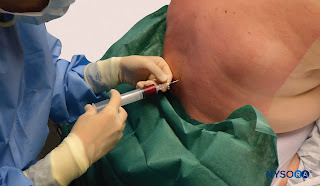Post spinal puncture headache.
The incidence of post spinal puncture headache is approximately 1% in spinal anesthesia. It results from unintentional or intentional puncture of the dura membrane. In obstetrics in case of accidental dural puncture up to 80% of patients subsequently developing a post-dural puncture headache.
Headaches are caused by leakage of spinal fluid through a puncture hole in the dura mater.This leakage decreases the pressure of the spinal fluid and may cause traction on pain-sensitive intracranial structures as the brain loses support and sags.
The onset of headache is usually within 24–48 h after dural puncture or sometimes later. It is a frontal or occipital headache that worsens with the upright or seated posture and is relieved by lying supine. Associated symptoms can include nausea, vomiting, neck pain, dizziness, tinnitus, diplopia, hearing loss, cortical blindness, cranial nerve palsies, and even seizures.
Headache usually resolves within a few days ( within 7 days in the majority (72%) of cases), but the longest reported headache after lumbar puncture lasted for 19 months.
Factors contributing to the development of headache after lumbar puncture:
- Sex: Females > males
- Needle size: larger > smaller
- Number of lumbar puncture attempts
- Needle bevel: less when the needle bevel is placed in the long axis of the neuraxis
- Pregnancy: more when pregnant
- Dural punctures: more with multiple punctures
Factors not influencing the incidence of headache:
- Continuous spinal infusion
- The volume of the spinal fluid removed
- There is no convincing evidence to suggest any particular position to reduce the incidence of headache.
- The incidence of headache does not depend on the CSF opening pressure, CSF analysis or the volume of CSF removed.
Management:
Patients should be encouraged to lie in a comfortable position, which is mostly in the supine position owing to the postural nature of the symptoms.
Supporting treatment:
Increased hydration was recommended but several studies have shown that increased fluid intake has no effect on CSF production.
Caffeine acts as a cerebral vasoconstrictor by blocking adenosine receptors, which has a role in the pathogenesis of headache after lumbar puncture. Intravenous administration of 500 mg of caffeine sodium benzoate relieved 75% of headaches, although the recurrence of headache after caffeine treatment is frequent. Caffeine is also available as an oral form.
Simple analgesics, opioids and anti‐emetics may control the symptoms in milder cases. Generally, >85% of headaches after lumbar puncture will resolve without any specific treatment.
The use of sumatriptan has varying effects.
A blood patch is ideally performed 24 hours after dural puncture and after the development of classic post–dural puncture headache symptoms. About 20–30 ml of blood is then taken from a large vein, usually from the patient's arm, and injected immediately but slowly into the epidural space through the epidural needle. A second epidural blood patch may be performed 24 to 48 hours if the first is ineffective.
Surgical closure of the dural gap. This is the last resort treatment where other treatments have failed.



